| |
'Save the Sharks — Save the Oceans' ™ |
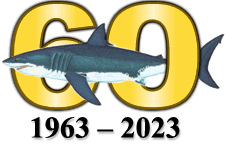 |
|
|
Distribution and Diet of Pacific Coast White Sharks
The White Shark's known range along the Pacific Coast of the United States
and Canada extends from Imperial Beach, San Diego County, California,
near the Mexican border, in the south, to the northwest Bering Sea
off the Aleutian Islands, Alaska, in the north. This range distribution
was determined from attacks, captures, strandings, and reliable observations.
White Shark attacks on humans have been authenticated from California,
Oregon and Washington. In addition to their attacks on humans, White
Sharks have also attacked boats and struck at, or bitten, numerous
other inanimate objects during the Twentieth Century. These incidents
were reported from California, Oregon, and Vancouver Island, British
Columbia, Canada. During the Twentieth Century, at least one observation,
stranding, or capture of a White Shark was reported from California,
Oregon, Washington, Vancouver Island, Alaska, and the Bering Sea.
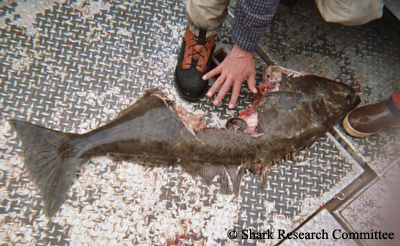 Yakutat,
Alaska — Yakutat,
Alaska —
On Monday, September 6, 2004 charter boat captain Mark Sappington
was 14 miles offshore from Yakutat, Alaska, which is about 250 miles
north west of Sitka. He had six clients aboard his 30 ft halibut charter
fishing boat "Manifest Destiny." Sappington said
one of his "guys" had hooked a halibut and while
bringing the fish to the surface the line on the reel suddenly began
to "run out" as if something big had taken the
fish. He said, "It was obvious that the fish wasn't pulling
out the line."
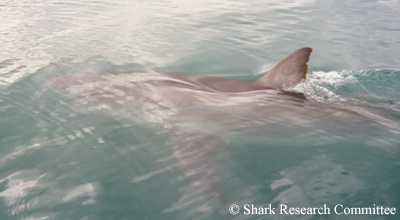 When
the fish was finally reeled to the surface a large bite, at least
18 inches across, had been removed from the 60 lb halibut. The fishermen
quickly removed the halibut from the water as a large white shark
began to circle the boat. Sappington said, "It circled the
boat three times before it mouthed the swim step for several seconds.
After it let go of the swim step it circle the boat five more times.
It was definitely a great white about 20 feet in length."
The encounter left all on board breathless with a feeling of a once
in a lifetime experience. However, this might have been the second
time in as many days that Sappington had encountered this shark. On
Sunday, the day before, a charter member aboard Sappington's boat
had 400 pound test wire line stripped completely off of his reel at
an unbelievable speed. He believes it was the same shark. Sappington
said, "It was in the same place at the same time of day." When
the fish was finally reeled to the surface a large bite, at least
18 inches across, had been removed from the 60 lb halibut. The fishermen
quickly removed the halibut from the water as a large white shark
began to circle the boat. Sappington said, "It circled the
boat three times before it mouthed the swim step for several seconds.
After it let go of the swim step it circle the boat five more times.
It was definitely a great white about 20 feet in length."
The encounter left all on board breathless with a feeling of a once
in a lifetime experience. However, this might have been the second
time in as many days that Sappington had encountered this shark. On
Sunday, the day before, a charter member aboard Sappington's boat
had 400 pound test wire line stripped completely off of his reel at
an unbelievable speed. He believes it was the same shark. Sappington
said, "It was in the same place at the same time of day."
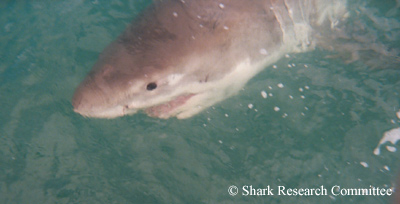 A
biologist with the Alaska Department of Fish & Game said this
was the fourth report of a large white shark in Southeast Alaska this
year. Historically, white sharks are no strangers to the coastal waters
of Alaska. In the summer of 1981 a salmon fisherman caught a white
shark off Yakutat that measured more than 18 feet in length. Authenticated
records of white shark captures and strandings date back to at least
1961 in the scientific literature. (Photographs courtesy of John Huppert) A
biologist with the Alaska Department of Fish & Game said this
was the fourth report of a large white shark in Southeast Alaska this
year. Historically, white sharks are no strangers to the coastal waters
of Alaska. In the summer of 1981 a salmon fisherman caught a white
shark off Yakutat that measured more than 18 feet in length. Authenticated
records of white shark captures and strandings date back to at least
1961 in the scientific literature. (Photographs courtesy of John Huppert)
Over the preceding four decades, captures or strandings of White
Sharks have provided valuable insights into their biology —
including dietary preferences. A brief description of a stranding
and a capture are presented below.
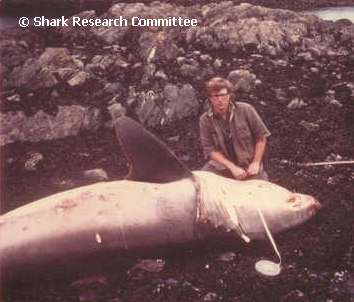 In
late September 1977 a local air taxi operator sighted a large shark
stranded on a beach 16 miles southwest of Ketchikan, Alaska. Fisheries
biologist Robert Larson examined the shark on 30 September 1977. The
adult male White Shark was 15 feet 4 inches in total length. Upon
dissection of the shark's stomach about 100 opaque circular objects
were discovered, each about 0.25 inches in diameter. John E. Fitch,
Research Director, California Department of Fish & Game, Long
Beach, subsequently identified them as lenses from fish eyes, most
probably salmonids. The number of lenses present in the shark's stomach
suggests that fish might provide a larger percentage of adult White
Shark nutritional requirements than previously thought. Although White
Sharks appear to prefer pinnipeds (seals and sea lions) as their main
staple after attaining maturity, they still consume fish. This fact
has been overtly omitted, or frequently understated, over the last
two or three decades by some White Shark researchers. The irrefutable
evidence from this stranding tells us that adult White Sharks are
apparently opportunistic predators and will readily take any prey
species that is available. In
late September 1977 a local air taxi operator sighted a large shark
stranded on a beach 16 miles southwest of Ketchikan, Alaska. Fisheries
biologist Robert Larson examined the shark on 30 September 1977. The
adult male White Shark was 15 feet 4 inches in total length. Upon
dissection of the shark's stomach about 100 opaque circular objects
were discovered, each about 0.25 inches in diameter. John E. Fitch,
Research Director, California Department of Fish & Game, Long
Beach, subsequently identified them as lenses from fish eyes, most
probably salmonids. The number of lenses present in the shark's stomach
suggests that fish might provide a larger percentage of adult White
Shark nutritional requirements than previously thought. Although White
Sharks appear to prefer pinnipeds (seals and sea lions) as their main
staple after attaining maturity, they still consume fish. This fact
has been overtly omitted, or frequently understated, over the last
two or three decades by some White Shark researchers. The irrefutable
evidence from this stranding tells us that adult White Sharks are
apparently opportunistic predators and will readily take any prey
species that is available.
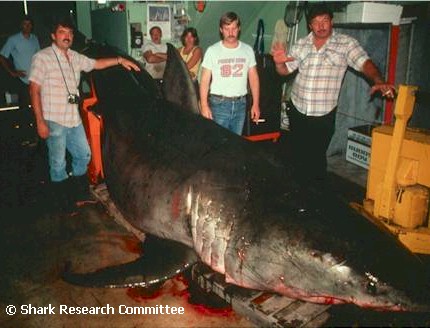 Commercial
fisherman Joe Friscia captured an adult female White Shark in his
drift gill net on 18 September 1985, about 15 miles southwest of Point
Vicente, Los Angeles County, California. The shark was 17 feet 7 inches
in length and weighed 4,140 pounds. The accuracy of the shark's weight
is indisputable. The 'truck scale' used to weigh the shark was checked
by the California Department of Weights and Measures and found to
be accurate to within 5 pounds. When the shark's stomach was dissected
it was found to contain the remnants of two pinnipeds — an adult
Harbor Seal (Phoca vitulina) and a 'roto tagged' juvenile Elephant
Seal (Mirounga angustirostris). Examination of the shark's
jaws revealed three individual rows of upper lateral teeth to be anomalous.
Upon closer scrutiny, over a dozen stingers of Bat Rays (Myliobatus
californicus) were found imbedded in the shark's upper and lower
jaws. Several of these stingers had penetrated tooth germ sites (the
area of the jaw where tooth formation occurs), causing permanent damage
to these three individual teeth. Several of the stinger wounds were
recent, suggesting that this shark had fed not only on pinnipeds but
also on benthic (bottom-dwelling) Bat Rays (Photograph courtesy Gordon
Hubbell). Commercial
fisherman Joe Friscia captured an adult female White Shark in his
drift gill net on 18 September 1985, about 15 miles southwest of Point
Vicente, Los Angeles County, California. The shark was 17 feet 7 inches
in length and weighed 4,140 pounds. The accuracy of the shark's weight
is indisputable. The 'truck scale' used to weigh the shark was checked
by the California Department of Weights and Measures and found to
be accurate to within 5 pounds. When the shark's stomach was dissected
it was found to contain the remnants of two pinnipeds — an adult
Harbor Seal (Phoca vitulina) and a 'roto tagged' juvenile Elephant
Seal (Mirounga angustirostris). Examination of the shark's
jaws revealed three individual rows of upper lateral teeth to be anomalous.
Upon closer scrutiny, over a dozen stingers of Bat Rays (Myliobatus
californicus) were found imbedded in the shark's upper and lower
jaws. Several of these stingers had penetrated tooth germ sites (the
area of the jaw where tooth formation occurs), causing permanent damage
to these three individual teeth. Several of the stinger wounds were
recent, suggesting that this shark had fed not only on pinnipeds but
also on benthic (bottom-dwelling) Bat Rays (Photograph courtesy Gordon
Hubbell).
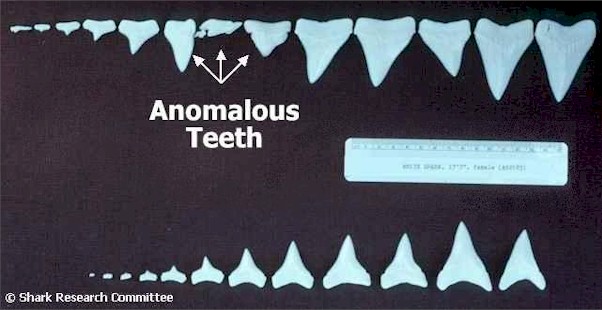
During the Twentieth Century there were many references to fish, and
even crustaceans, being found in the digestive tracts of adult White
Sharks that were captured off the Pacific Coast. The variety and number
of marine mammals, fishes and crustaceans reported from these specimens
suggests that the only preference adult White Sharks might have when
actively hunting is the availability of the prey, rather than its
species.
Dietary Stages and Carrion Feeding
Research of the adult White Shark's predatory behavior has yielded some intriguing data, in addition to some exciting film footage. The sight of a three or four thousand pound shark leaping vertically out of the water, in a 'Polaris Attack' on a marine mammal, sends chills through our collective psyches. Then again juvenile White Sharks are incapable of capturing adult marine mammals and must employ other strategies to feed on smaller prey. The variety of predatory strategies and prey in the White Shark diet has lead to much speculation about 'shifts' from one form of feeding to another. To clarify these dietary stages a brief discussion would seem appropriate. The following is what is currently known about the diet of the White Shark from juvenile to adult, followed by a description of a form of feeding not usually discussed in the literature.
Some researchers have suggested that the White Shark has a 'shift' in its diet when it reaches a length of about 3 meters. It is hypothesized that they cease feeding upon fish and invertebrates and begin a diet consisting exclusively of marine mammals. Webster's Dictionary defines 'shift' as; 'to replace by another or others; change or exchange .' I propose that the diet 'expands' to include additional prey items as the shark's length increases. Webster defines 'expand' as 'to make greater in size, bulk, scope, etc.; enlarge; dilate; extend.' If we apply this 'expansion' hypothesis then the dietary stages, and/or preferences, of the White Shark throughout its life are a function of two components - availability and capability. Simply put, a White Shark will pursue any prey species that is readily available and that the shark is capable of capturing. Although marine mammals are plentiful along the Pacific Coast, a juvenile White Shark is not capable of capturing an adult marine mammal so its diet consists of those prey species that it can capture successfully; fishes and invertebrates. Conversely, an adult White Shark is capable of capturing adult marine mammals, especially Elephant Seals (Mirounga angustirostris) .
In 1962 the Shark Research Committee began a research project to determine the causal species and motivations for shark/human interactions along the Pacific Coast of North America. This project continues to this day. A by-product of this research was the field and laboratory studies that were conducted on dozens of juvenile and adult White Sharks. It was determined by the middle 1970s that juvenile White Sharks were 'pupped' in the early spring, close inshore, from Pt. Conception, Santa Barbara South to the Mexican border. This specific region of coastline provides the habitat necessary for the newborn shark's survival. Examination of juvenile White Shark stomach contents revealed numerous prey species including; invertebrates, benthic sharks and rays, and fishes. There was one prey species in particular that was frequently found in the stomachs that were examined - the California Grunion (Leuresthes tenuis) ( see grunion ) .
As newborns and yearlings, White Shark energy reserves, which are concentrated in their livers, are minimal at best so it is necessary that they begin to feed immediately. It is not surprising that juvenile White Sharks are frequently observed close inshore off Southern California beaches from April to September, the same months coincidentally that Grunion spawns occur. Thousands of egg-laden Grunion provides a bountiful supply of protein twice monthly for the young White Shark, a necessity for the newborn sharks if they are to survive their first year of life. In addition to Grunion, the young sharks also feed on other fishes that are attracted to these spawns.
 At a length of 2 to 3 meters the White Shark's diet expands to include pelagic fishes, such as tunas and mackerels. After attaining a length of 3 meters, the sub-adult White Shark is now capable of capturing marine mammal prey, like Harbor Seals (Phoca vitulina) and California Sea Lions (Zalophus californianus) . Photograph of the Harbor Seal taken at the Children's Pool, La Jolla in 2005 courtesy of Debbie Beacham clearly demonstrates a White Shark bite. This is also the size when the shark starts employing 'Polaris Attacks' when hunting their marine mammal prey. It is believed that this type of hunting strategy either disables or kills the prey on impact, thereby reducing the likelihood of injury to the shark from the struggling pinniped. Larger marine mammals, such as the Elephant Seal, seem to be a favored prey of White Sharks over 4 meters in length. The size of both predator and prey would seem to be the determining factor in this dietary stage. However, this does not mean that adult White Sharks consume only marine mammals. As noted in previous examples, pelagic and benthic fishes, crustaceans, and invertebrates remain an import source of energy in the adult White Shark diet. At a length of 2 to 3 meters the White Shark's diet expands to include pelagic fishes, such as tunas and mackerels. After attaining a length of 3 meters, the sub-adult White Shark is now capable of capturing marine mammal prey, like Harbor Seals (Phoca vitulina) and California Sea Lions (Zalophus californianus) . Photograph of the Harbor Seal taken at the Children's Pool, La Jolla in 2005 courtesy of Debbie Beacham clearly demonstrates a White Shark bite. This is also the size when the shark starts employing 'Polaris Attacks' when hunting their marine mammal prey. It is believed that this type of hunting strategy either disables or kills the prey on impact, thereby reducing the likelihood of injury to the shark from the struggling pinniped. Larger marine mammals, such as the Elephant Seal, seem to be a favored prey of White Sharks over 4 meters in length. The size of both predator and prey would seem to be the determining factor in this dietary stage. However, this does not mean that adult White Sharks consume only marine mammals. As noted in previous examples, pelagic and benthic fishes, crustaceans, and invertebrates remain an import source of energy in the adult White Shark diet.
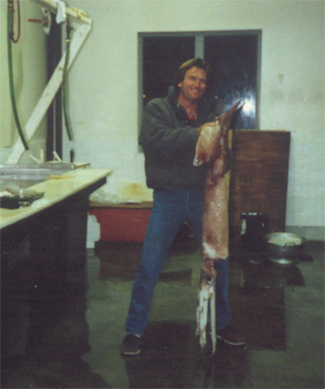 One particular case in support of the 'diet expansion' hypothesis was provided in August 1987 when an adult White Shark was captured near Santa Cruz, California. The female shark was 15 feet 10 inches in length and weighed 3,760 pounds. When dissected a Humboldt Squid (Dosidicus gigas) was removed from the stomach. The tentacles had been severed approximately 18 inches from their point of insertion. The squid are most commonly found at depths of 660 - 2,300 feet (200 - 700 meters), although trips into shallower water have been observed in the Sea of Cortez and along the California Coast. This is another example that supports the contention that White Sharks, like most predators, will prey upon any prey species that is available and that they are capable of capturing. One particular case in support of the 'diet expansion' hypothesis was provided in August 1987 when an adult White Shark was captured near Santa Cruz, California. The female shark was 15 feet 10 inches in length and weighed 3,760 pounds. When dissected a Humboldt Squid (Dosidicus gigas) was removed from the stomach. The tentacles had been severed approximately 18 inches from their point of insertion. The squid are most commonly found at depths of 660 - 2,300 feet (200 - 700 meters), although trips into shallower water have been observed in the Sea of Cortez and along the California Coast. This is another example that supports the contention that White Sharks, like most predators, will prey upon any prey species that is available and that they are capable of capturing.
In summary these three dietary stages all require the hunting and capturing of the prey, whether invertebrate, fish, or marine mammal. A more efficient method of obtaining food, in terms of energy conservation, is carrion feeding, although it would be difficult to even hazard a guess as to what percentage of an adult White Shark's energy requirements are provided by this type of feeding. Generally, the carcasses involved in this form of feeding are whales, which have been shown to have energy-rich blubber. This is a very efficient method for the adult White Shark to obtain its energy requirements. The shark expends a minimum amount of energy to obtain a maximum amount of high-caloric, energy-rich blubber. These feeding events are frequently observed by fishermen aboard sport and/or commercial fishing vessels. The following is an example of a carrion-feeding White Shark.
On 10 September 1989, Tony DiCristo and his fishing companion, Dan Fink, were aboard the 'Velmar,' DiCristo's 11.6-meter fiberglass boat, gently drifting about 10 kilometers off Palos Verdes Estates, Los Angeles County, California (33°46.0' N; 118°20.0' W). They were taking turns filming a 4-to-5-meter White Shark that was feeding on the carcass of a whale. The current had slowly carried the boat close to the carcass of the whale, tentatively identified as a Humpback Whale (Megaptera novaeangliae), when the shark abruptly abandoned its feeding, turned and swam over to the 'Velmar,' and bit the swim step several times. The shark caused only minimal damage to the step, but its actions shocked both fishermen. The shark then sounded and was not observed for several minutes. However, after DiCristo moved the boat 10 to 15 meters from the whale the shark returned to feed. Within several minutes the boat had again drifted to within 3 to 5 meters of the whale, whereupon the shark suddenly turned and, moving swiftly, rammed the boat several times, pushing it several meters across the surface. These startling events took place over a four-to-five-hour period. Both fishermen described the shark's actions as being more combative than predatory, almost like it was attempting to 'frighten or chase us away, rather than eat the boat .' Whenever the boat would drift near the whale, the shark would abandon the carcass and focus its attention on the boat. |
|
 |
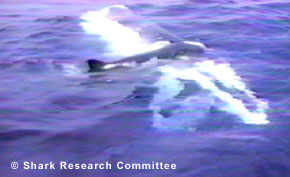 |
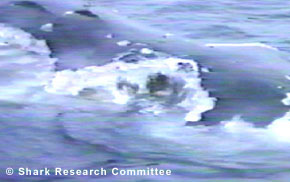 |
|


 Yakutat,
Alaska —
Yakutat,
Alaska —  When
the fish was finally reeled to the surface a large bite, at least
18 inches across, had been removed from the 60 lb halibut. The fishermen
quickly removed the halibut from the water as a large white shark
began to circle the boat. Sappington said, "It circled the
boat three times before it mouthed the swim step for several seconds.
After it let go of the swim step it circle the boat five more times.
It was definitely a great white about 20 feet in length."
The encounter left all on board breathless with a feeling of a once
in a lifetime experience. However, this might have been the second
time in as many days that Sappington had encountered this shark. On
Sunday, the day before, a charter member aboard Sappington's boat
had 400 pound test wire line stripped completely off of his reel at
an unbelievable speed. He believes it was the same shark. Sappington
said, "It was in the same place at the same time of day."
When
the fish was finally reeled to the surface a large bite, at least
18 inches across, had been removed from the 60 lb halibut. The fishermen
quickly removed the halibut from the water as a large white shark
began to circle the boat. Sappington said, "It circled the
boat three times before it mouthed the swim step for several seconds.
After it let go of the swim step it circle the boat five more times.
It was definitely a great white about 20 feet in length."
The encounter left all on board breathless with a feeling of a once
in a lifetime experience. However, this might have been the second
time in as many days that Sappington had encountered this shark. On
Sunday, the day before, a charter member aboard Sappington's boat
had 400 pound test wire line stripped completely off of his reel at
an unbelievable speed. He believes it was the same shark. Sappington
said, "It was in the same place at the same time of day."
 A
biologist with the Alaska Department of Fish & Game said this
was the fourth report of a large white shark in Southeast Alaska this
year. Historically, white sharks are no strangers to the coastal waters
of Alaska. In the summer of 1981 a salmon fisherman caught a white
shark off Yakutat that measured more than 18 feet in length. Authenticated
records of white shark captures and strandings date back to at least
1961 in the scientific literature. (Photographs courtesy of John Huppert)
A
biologist with the Alaska Department of Fish & Game said this
was the fourth report of a large white shark in Southeast Alaska this
year. Historically, white sharks are no strangers to the coastal waters
of Alaska. In the summer of 1981 a salmon fisherman caught a white
shark off Yakutat that measured more than 18 feet in length. Authenticated
records of white shark captures and strandings date back to at least
1961 in the scientific literature. (Photographs courtesy of John Huppert) In
late September 1977 a local air taxi operator sighted a large shark
stranded on a beach 16 miles southwest of Ketchikan, Alaska. Fisheries
biologist Robert Larson examined the shark on 30 September 1977. The
adult male White Shark was 15 feet 4 inches in total length. Upon
dissection of the shark's stomach about 100 opaque circular objects
were discovered, each about 0.25 inches in diameter. John E. Fitch,
Research Director, California Department of Fish & Game, Long
Beach, subsequently identified them as lenses from fish eyes, most
probably salmonids. The number of lenses present in the shark's stomach
suggests that fish might provide a larger percentage of adult White
Shark nutritional requirements than previously thought. Although White
Sharks appear to prefer pinnipeds (seals and sea lions) as their main
staple after attaining maturity, they still consume fish. This fact
has been overtly omitted, or frequently understated, over the last
two or three decades by some White Shark researchers. The irrefutable
evidence from this stranding tells us that adult White Sharks are
apparently opportunistic predators and will readily take any prey
species that is available.
In
late September 1977 a local air taxi operator sighted a large shark
stranded on a beach 16 miles southwest of Ketchikan, Alaska. Fisheries
biologist Robert Larson examined the shark on 30 September 1977. The
adult male White Shark was 15 feet 4 inches in total length. Upon
dissection of the shark's stomach about 100 opaque circular objects
were discovered, each about 0.25 inches in diameter. John E. Fitch,
Research Director, California Department of Fish & Game, Long
Beach, subsequently identified them as lenses from fish eyes, most
probably salmonids. The number of lenses present in the shark's stomach
suggests that fish might provide a larger percentage of adult White
Shark nutritional requirements than previously thought. Although White
Sharks appear to prefer pinnipeds (seals and sea lions) as their main
staple after attaining maturity, they still consume fish. This fact
has been overtly omitted, or frequently understated, over the last
two or three decades by some White Shark researchers. The irrefutable
evidence from this stranding tells us that adult White Sharks are
apparently opportunistic predators and will readily take any prey
species that is available. Commercial
fisherman Joe Friscia captured an adult female White Shark in his
drift gill net on 18 September 1985, about 15 miles southwest of Point
Vicente, Los Angeles County, California. The shark was 17 feet 7 inches
in length and weighed 4,140 pounds. The accuracy of the shark's weight
is indisputable. The 'truck scale' used to weigh the shark was checked
by the California Department of Weights and Measures and found to
be accurate to within 5 pounds. When the shark's stomach was dissected
it was found to contain the remnants of two pinnipeds — an adult
Harbor Seal (Phoca vitulina) and a 'roto tagged' juvenile Elephant
Seal (Mirounga angustirostris). Examination of the shark's
jaws revealed three individual rows of upper lateral teeth to be anomalous.
Upon closer scrutiny, over a dozen stingers of Bat Rays (Myliobatus
californicus) were found imbedded in the shark's upper and lower
jaws. Several of these stingers had penetrated tooth germ sites (the
area of the jaw where tooth formation occurs), causing permanent damage
to these three individual teeth. Several of the stinger wounds were
recent, suggesting that this shark had fed not only on pinnipeds but
also on benthic (bottom-dwelling) Bat Rays (Photograph courtesy Gordon
Hubbell).
Commercial
fisherman Joe Friscia captured an adult female White Shark in his
drift gill net on 18 September 1985, about 15 miles southwest of Point
Vicente, Los Angeles County, California. The shark was 17 feet 7 inches
in length and weighed 4,140 pounds. The accuracy of the shark's weight
is indisputable. The 'truck scale' used to weigh the shark was checked
by the California Department of Weights and Measures and found to
be accurate to within 5 pounds. When the shark's stomach was dissected
it was found to contain the remnants of two pinnipeds — an adult
Harbor Seal (Phoca vitulina) and a 'roto tagged' juvenile Elephant
Seal (Mirounga angustirostris). Examination of the shark's
jaws revealed three individual rows of upper lateral teeth to be anomalous.
Upon closer scrutiny, over a dozen stingers of Bat Rays (Myliobatus
californicus) were found imbedded in the shark's upper and lower
jaws. Several of these stingers had penetrated tooth germ sites (the
area of the jaw where tooth formation occurs), causing permanent damage
to these three individual teeth. Several of the stinger wounds were
recent, suggesting that this shark had fed not only on pinnipeds but
also on benthic (bottom-dwelling) Bat Rays (Photograph courtesy Gordon
Hubbell).
 At a length of 2 to 3 meters the White Shark's diet expands to include pelagic fishes, such as tunas and mackerels. After attaining a length of 3 meters, the sub-adult White Shark is now capable of capturing marine mammal prey, like Harbor Seals (Phoca vitulina) and California Sea Lions (Zalophus californianus) . Photograph of the Harbor Seal taken at the Children's Pool, La Jolla in 2005 courtesy of Debbie Beacham clearly demonstrates a White Shark bite. This is also the size when the shark starts employing 'Polaris Attacks' when hunting their marine mammal prey. It is believed that this type of hunting strategy either disables or kills the prey on impact, thereby reducing the likelihood of injury to the shark from the struggling pinniped. Larger marine mammals, such as the Elephant Seal, seem to be a favored prey of White Sharks over 4 meters in length. The size of both predator and prey would seem to be the determining factor in this dietary stage. However, this does not mean that adult White Sharks consume only marine mammals. As noted in previous examples, pelagic and benthic fishes, crustaceans, and invertebrates remain an import source of energy in the adult White Shark diet.
At a length of 2 to 3 meters the White Shark's diet expands to include pelagic fishes, such as tunas and mackerels. After attaining a length of 3 meters, the sub-adult White Shark is now capable of capturing marine mammal prey, like Harbor Seals (Phoca vitulina) and California Sea Lions (Zalophus californianus) . Photograph of the Harbor Seal taken at the Children's Pool, La Jolla in 2005 courtesy of Debbie Beacham clearly demonstrates a White Shark bite. This is also the size when the shark starts employing 'Polaris Attacks' when hunting their marine mammal prey. It is believed that this type of hunting strategy either disables or kills the prey on impact, thereby reducing the likelihood of injury to the shark from the struggling pinniped. Larger marine mammals, such as the Elephant Seal, seem to be a favored prey of White Sharks over 4 meters in length. The size of both predator and prey would seem to be the determining factor in this dietary stage. However, this does not mean that adult White Sharks consume only marine mammals. As noted in previous examples, pelagic and benthic fishes, crustaceans, and invertebrates remain an import source of energy in the adult White Shark diet.  One particular case in support of the 'diet expansion' hypothesis was provided in August 1987 when an adult White Shark was captured near Santa Cruz, California. The female shark was 15 feet 10 inches in length and weighed 3,760 pounds. When dissected a Humboldt Squid (Dosidicus gigas) was removed from the stomach. The tentacles had been severed approximately 18 inches from their point of insertion. The squid are most commonly found at depths of 660 - 2,300 feet (200 - 700 meters), although trips into shallower water have been observed in the Sea of Cortez and along the California Coast. This is another example that supports the contention that White Sharks, like most predators, will prey upon any prey species that is available and that they are capable of capturing.
One particular case in support of the 'diet expansion' hypothesis was provided in August 1987 when an adult White Shark was captured near Santa Cruz, California. The female shark was 15 feet 10 inches in length and weighed 3,760 pounds. When dissected a Humboldt Squid (Dosidicus gigas) was removed from the stomach. The tentacles had been severed approximately 18 inches from their point of insertion. The squid are most commonly found at depths of 660 - 2,300 feet (200 - 700 meters), although trips into shallower water have been observed in the Sea of Cortez and along the California Coast. This is another example that supports the contention that White Sharks, like most predators, will prey upon any prey species that is available and that they are capable of capturing. 

